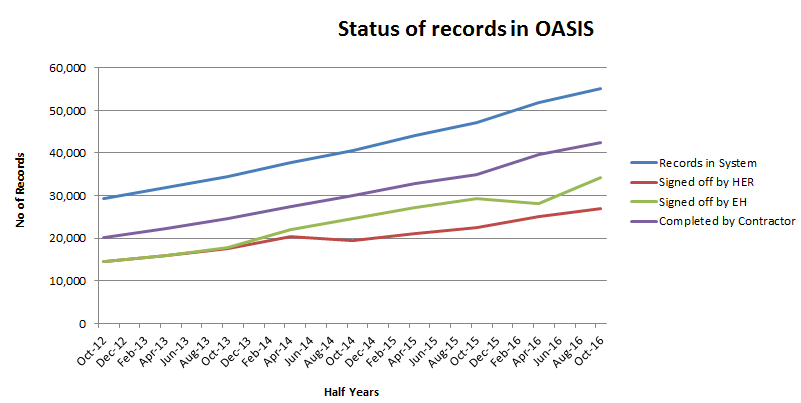The OASIS management board meets twice a year and has met now 28 times. Many of these meetings have been comfortingly routine but over the last few occasions the HERALD project: redeveloping OASIS and creating the ADS Library has meant there is more than just the general use of OASIS across the country to discuss.
The board has representatives from ADS, ALGAO England and Scotland, Archaeology Scotland, Council for British Archaeology, Historic England, Historic Environment Scotland, IHBC, RCAHMW and the Society of Museum Archaeology.

The general format of the meeting is that we receive monitoring reports from Mark Barratt on the use of OASIS in England, Peter McKeague for Scotland and from ADS for technical helpdesk trends and this time there was also a report from Tim Evans, ADS on the use of grey literature as highlighted in the Roman Rural Settlement Project.
There was a update on the transfer of BIAB and the ADS Grey literature library and Journal archives to the ADS Library with the launch intended for early December.
The update on OASIS was followed by discussions focusing on a few aspects of how the new system would function:
- How current unsigned-off records in OASIS would be dealt with on transfer to the new system, there are many thousands of these records. There will be a plan for transferring these records and they will be treated differently depending on how complete the records are and if the organisation which started them is still in business. Essentially more complete records should find their way into the ADS Library and very sparse or incomplete records will be moth-balled so as not to clog up the new system but will be retrievable if required. The specifics of this plan will be approved by the management board members and specifically ALGAO at a future date to cover any implications of releasing legacy material.
- A related but different point was how long reports should be held by HERs before they will automatically transfer to the ADS Library. This mechanism is proposed to remedy the current problem of reports being stuck in the system where HERs do not have the resource to validate reports. One month was seen to be too short for HERs but six months was too long for contractors to wait to see their reports in the Library. Three months has been proposed as a middle ground and this is going to be compared to the average time it takes a report to pass through OASIS currently and discussed with ALGAO for approval.
- There was also a discussion on how to deal with records where a company has ceased trading. A procedure will be formalised and will now be written in to the terms and conditions of use for the new system.
- There is a need to improve awareness of OASIS with Development Control Archaeologists – if they receive and sign off reports using OASIS there would be fewer issues of the wrong report being released into the Library.
- Related to this again was a the discussion of the automatic release of reports into the library could mean that draft reports will find their way into the Library. This was at first seen as a problem, however as discussions progressed it was noted that it is now normal practise in academic circles to release pre-publication versions of an article into repositories as a requirement of funding bodies. These receive a DOI and are then seen alongside the published version once that becomes available.
The next stage of the HERALD project after the release of the ADS Library is the production of functional specification in January next year. This follows a suite of final consultations, the last couple of which will be appearing on this blog soon.
The next OASIS and BIAB management board meeting will be held in April 2017.